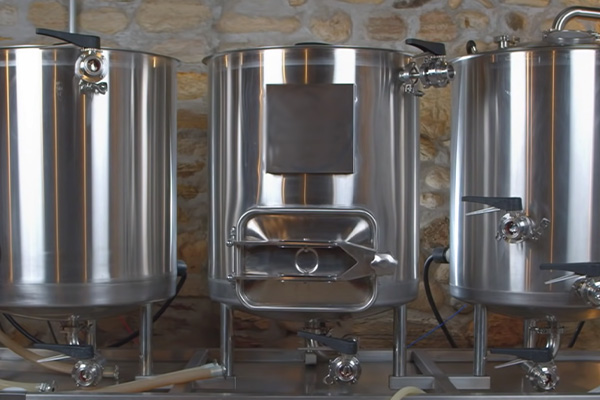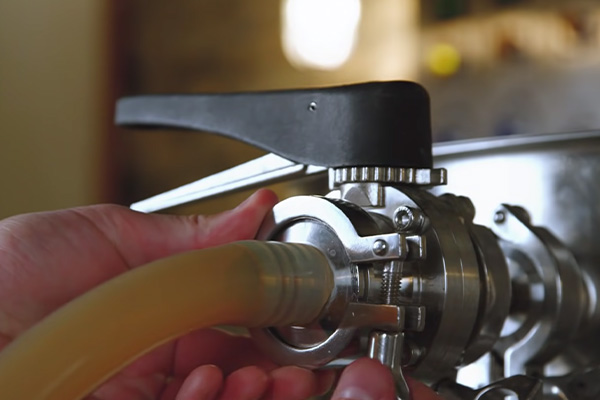If you’ve always been a fan of beer…
…and for decades, you’ve mastered the craft of beer brewing in the comfort of your home.
Then, suddenly – you had a light bulb moment – and thought of starting a small business around beer.
So, you start to wonder – with questions like…
Will I be allowed by the law? How much money do I need? Will I be profitable? Where do I set up everything?
A thousand questions – plus more!
Here’s the thing…
If you want to start small instead of going all out – you’re in the right place!
Here at Brew Dog Metrics, we’ll talk about nano-brewery and interesting things related to the commercial brewing environment.
One piece of advice, though…
…it’ll be a long haul but don’t be afraid to start small.
Think big while you start small – or, let’s say – nano.
NanoBrewery

You may know about this type of brewery – or not at all.
It’s one of the most common types of breweries – along with a macro brewery, micro brewery, craft brewery, brewpub, farm brewery, and contract brewing company.
Nano brewery is a scaled-down micro brewery that produces three barrels or less of beer batches.
It’s the smallest type of brewery that requires small capital – but with lower profits.
Theoretically…
You can even go smaller – instead of diving to nano breweries. Some brewers categorized themselves as pico breweries.
There’s no formal brewing industry definition, but brewers in this category produce less than five hundred kegs annually.
Anything less than this…
…and you’re most likely producing beer for yourself and potentially a few pals.
In the end…
Pico brewery is too small to be a profitable business, and this is something brewers do for experience and enjoyment rather than for money.
On a positive note…
A pico brewery isn’t bad as it provides valuable professional brewing experience for beer making.
Plus, it’s a good stepping stone towards running a nano brewery.
However…
…different market segments exist in the craft beer business. Most state laws prohibit the sale of beer directly to the consumer.
Aside from that…
Some states would allow breweries to act as a wholesaler – providing their beer directly to the retailer – and even allowing breweries to sell to the consumer directly.
Thankfully. These states have divided breweries into groups based on yearly beer output and on-site sales percentage.
For us to know more in-depth about the other categories – let’s move on to the next!
Types of Brewery
Macro brewery
From the name itself – macro – the largest type of brewery that has an annual production of six million barrels of beer of more
This might ring a bell…
Anheuser-Busch InBev, Heineken, Molson Coors Beverage Company, and Carlsberg are the largest macro brewer companies to operate and distribute their beers worldwide.
Micro brewery
The opposite of macro – micro brewery. To be labeled as such requires an annual production of 15,000 barrels of beer or less.
Micro companies should sell 75% or more of their off-site beer locations. If they sold more than 25% of canned or bottled beers at their facility – it’s now considered a taproom brewer.
What?
Some microbreweries have taprooms where they hold beer tasting – though it’s not necessary to sell beer on-site. But, still, a good thing.
Additionally…
This brewery often brews its specialty beers in small batches, serving seasonal, unique ingredients and brewing methods.
Craft brewery
A craft brewery is considered a small and independent brewery that produces beer annually with less than 6 million barrels.
Here’s the catch…
Even as the market output grows – craft breweries grow as well – but still considered craft.
In contrast…
According to the Brewers Association, 25% or less were owned or controlled by – let’s say – macro brewery. Then, it’s no longer considered a craft brewery, and it should be owned independently to be labeled as such.
Aside from that…
Craft breweries focus more on innovation in which they took unique twists on craft brewing and developed new recipes.
They may also try using non-traditional ingredients outside of the typical malted barley.
Brewpub
While other types of brewers may spread their distribution throughout the state or across many states – a brewpub primarily serves the local market.
By law…
Brewpubs are labeled as such if they sell 25% or more of their beer on-site. If the law permits, they could also sell their products “to-go” or distribute them to smaller off-site locations.
Additionally…
Most brewpubs have well-established restaurants where they sell their own beer alongside food or drink from other breweries.
This is a good opportunity for restaurant owners to break into the beer industry. They have the chance to sample a brew for their customers.
Farm brewery
Farm breweries must utilize 60% of farm produce, such as barley, hops, wheat, rye, and corn, to make and sell beer.
But, this may vary from one state to another.
On the other hand…
They received agricultural benefits that aren’t available under standard brewery laws.
With a farm brewing license…
Brewers don’t need an additional liquor license or permit to serve beer by the glass.
Farm breweries can also sell their beer to retailers, local pubs, and restaurants, depending on the state.
Contract brewing company
If you know someone unable to keep up beer supply – contract brewing will appeal to them.
As it implies…
This type of brewery works based on agreements between parties that vary widely based on their business relationship – and they must decide what their responsibilities are.
Either they could be a full-time partner in the brewing process in which they agreed to provide equipment, recipes, and distribution.
Or…
Act as a marketing company for branding and distribution – leaving the beer production and packaging to the other party.
It can be an excellent option for both companies and brewers…
…especially brewers who attempt to build their own brand identity – a corporate partner might be a good bet.
However…
If a brewer needs to increase scale but needs assistance in packaging, the host brewery might only be limited.
Building a Nano Brewery
Nano breweries are founded for a few reasons.
If you’re motivated to follow your gut in exploring brewing at a level of nano-brewery – you need to consider a few – plus, many things – and this includes the following:
STEP 1: Check Your Local Laws – Legal Requirements
As previously mentioned…
Laws will require many things as this business would involve beer production, and each state will have its own requirements for opening and operating a brewery.
So, make sure to research specific requirements based on where you’ll be establishing a nano brewery.
Plus…
There are also basic obligations and legal documents you need to obtain.
Here are six important legal hurdles you might need to work through when starting a nano brewery business:
- Federal Brewer’s Permit: This permission allows a brewery to produce an unlimited amount of beer and to operate a restaurant on-site. You can obtain this from the Alcohol and Tobacco Tax and Trade Bureau.
- State Liquor License: You can offer alcohol to consumers with this license. Because rules differ from state to state, check your state’s liquor licensing laws before opening to the public.
- Brewer’s Bond: This is another type of liquor license that brewers must have to operate; it assures that your brewery will pay all federal and state taxes.
- Operating Agreement: This document explains all of the LLC’s rules and regulations (Limited Liability Company).
- Insurance (e.g., Property, casualty, and liability): Compensation for damages is covered.
- Retailer’s license: This license permits you to offer additional things on your premises, such as clothing and accessories.
STEP 2: Calculate Your Cost
Frankly, you need to make enough money to cover your day-to-day expenses. Otherwise, it might pin you down real quick.
So…
You need to figure out how much money you need to earn and calculate your operating costs.
The key to success as a nano brewery is charging enough per pint to profit while charging less than nearby restaurants.
Competitive pricing attracts folks searching for a good price on a fantastic drink, and those people can turn into long-term, dependable clients.
Here’s the catch…
Since nano breweries don’t have to pay a slew of distributors, most of the beers you’d sell are direct profits.
That said…
More of your earnings can go directly toward paying off your debts. Plus, supplement your income by providing other services – such as running a restaurant – though this comes with its own set of costs.
Speaking of restaurants…
Restaurants who wish to provide house beer but do not want to develop a full-scale brewery can construct a nano brewery.
Because of the small size – they may profit from lower-cost beer sales and build brand loyalty.
STEP 3: Improve Brewing Methods/Techniques
Simply put – bad business practices will ruin your nano-brewery even faster than bad beer – unless you’re already a professional.
I’m sure you’ll agree that…
…starting any type of brewery will require several years of skill as a homebrewer.
But…
You can reduce this by working at an established plant and acquiring brewery advice from specialists in a commercial brewing setting.
On the other hand…
Larger commercial breweries will have different equipment than you. So, you still need to practice with your actual equipment.
STEP 4: Make Other People Judge Your Beer
In reality…
You’ll need to brew hundreds of batches before you can make a great beer to sell. You won’t make much money on any of those batches, but you may surely enjoy them or share them with your friends.
Before you start a nano brewery…
…your beer should be excellent enough to compete in professional contests. You don’t have to win every contest you enter, but you should be able to persuade experienced judges that your beer is worth the time it takes to consume.
Aside from that…
Don’t settle remarks from friends – even if they claim they’d purchase your beer. Friends often have good intentions, but not everyone will agree with them even if they tell the truth.
Consider hiring a brewery consultant to get a true sense of what you need to do to get the business up and running.
STEP 5: Decide How Much To Produce
As a general guideline…
…brew at least one keg (31 gallons) at a time. Even if you’re still learning how to brew or experimenting with different batches – there’s no need to brew less than one barrel of beer at a time.
If you brew a complete keg…
You’ll have plenty to share and obtain people’s feedback if it turns out good. Even if it doesn’t, you’ll be brewing around the same quantity as normal.
Keep in mind that…
Some components are impacted by how much you brew at once – changing your brewing volumes regularly – might cause faults – and change the flavor of your drinks.
Then, again. Many nano breweries create two or three barrels simultaneously compared to craft breweries or microbreweries.
However…
You can wait until you have enough experience to do so.
STEP 6: Prepare For Unexpected Brewing Situations
It’s okay to make mistakes. Brewing is essentially a science – but it’s simple to get it wrong – especially if you handle everything yourself.
Like, for example…
…having faulty batches are unavoidable – it’s unrealistic to expect that every batch of beer you brew will be outstanding. And this is true when you’re experimenting and attempting to develop new tastes.
Fortunately…
Brewing knowledge will assist you in identifying issues in your batches and determining the best approach to prevent them in the future.
If you don’t know what’s wrong…
…you have deeper issues, and – to be honest – you need more experience. I cannot emphasize how crucial experience is in establishing a successful nano-brewery.
But, here’s what you can do.
Dump your faulty batches and try again – if feasible.
However…
If you don’t have anything else to serve, you might have to provide some to consumers anyhow.
If someone brings up the flavor – be truthful. Talk about the issue and explain what you’re doing to solve it.
But…
If you act as if there’s no problem, you will most likely push them away and lose future revenue.
STEP 7: Improve Your People Skills
Treat your customer as if you’re the customer.
People flock to nano breweries to have a pleasant conversation while having a blast with a good pale ale.
If you manage your business on your own – as most people do – how you interact with consumers has a huge influence on how they see your establishment.
On a positive note…
You have to view this as an opportunity.
Making friends with regulars is a terrific approach to attract them to return – the more customers, the better.
Remember that many visitors who visit breweries are either craft brewers or are very interested in the manufacturing process.
Engaging your regulars in a discussion can be a surprisingly effective technique of improving faulty batches since they may have some helpful ideas.
That being said…
It’s difficult to be friendly all day – every day. This is another area where prior experience is essential.
Make certain that you communicate well in other areas as well. Return phone calls and respond to emails as soon as possible.
Overall, strive to come off as nice and welcome to everyone who contacts you in any form.
STEP 8: Learn How To Run A Brewing Business
Whether you want to establish a craft brewery, micro brewery, or a nano brewery – you must learn how – and never stop learning how – to run the business.
You don’t necessarily need an MBA to run a brewery – you can go to a regular school, attend classes online, or even study independently.
And, as the saying goes, your experience can be your teacher. If you work for – let’s say – a microbrewery – that would be beneficial for learning how to run things.
Time management is also helpful. Running a business involves a lot of paperwork, so you won’t necessarily be able to spend all day brewing and serving drinks.
As part of this process…
Make sure you learn about local zoning laws, licenses, and accounting to make your brewery legal.
Even if you’re starting nano – don’t settle for less. Research all the information you need. Seek a lot of advice from other businesses. Listen to what they tell you.
This way, you’ll be able to plan ahead of time.
STEP 9: Develop A Business Plan/Feasibility Study
Before you get all intimidated…
This is more like a small experiment to test the beer market and prove that there’s space for your unique beer idea in mind.
As mentioned previously…
Running a nano brewery requires much less capital compared to, let’s say – a craft brewery or a micro brewery.
Thus, a nano-brewery is a good startup!
On the other hand…
A thorough business strategy is essential for launching a successful nano-brewery. These should include a market study, information about your business, a description of your products, marketing strategy, funding information, financial predictions, and other details.
I know, you’re starting nano – why worry about these things?
Even a good business fails when they don’t plan wisely and strategically. Great business plans may help you obtain bank financing and track your progress toward your company’s objectives.
Be as honest and thorough as possible. Don’t be afraid to point out any flaws or concerns – instead – use this as a chance to address them and figure out the best method to mitigate your risk.
Conclusion

Opening a brewery is much more than just making great beer.
It’s not too late to turn your dreams into reality, whether you’re a craft brewer, nano brewer, micro, or macro brewer.
Plus…
It’s good to know that so many people want to venture into a microbrewery, a craft brewery, or even a nano-brewery.
Just like you…
They start making beer for personal consumption – and eventually, master it.
Give yourself a chance of making it to the big time – that’s for you now.
Now…
Starting a brewing business is tedious and taxing – whether you produce beer in a million barrels or less – knowing the basics and planning ahead of time would help you in the long run.
Again. It’s up to your dedication and motivation to have a successful business.
Keep in mind that…
Before you sell beer off-site or on-site – you need to know the different rules of your state and abide by them.
Don’t be afraid to start small – even nano.




